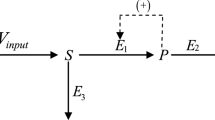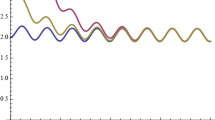Abstract
We consider a chain of metabolic reactions catalyzed by enzymes, of reversible Michaelis-Menten type with full dynamics, i.e. not reduced with any quasi-steady state approximations. We study the corresponding dynamical system and show its global stability if the equilibrium exists. If the system is open, the equilibrium may not exist. The main tool is monotone systems theory. Finally we study the implications of these results for the study of coupled genetic-metabolic systems.



Similar content being viewed by others
References
Bastin G, Guffens V (2006) Congestion control in compartmental network systems. Syst Control Lett 55:689–696
Belgacem I, Gouzé JL (2012) Global stability of full open reversible Michaelis-Menten reactions. In: 8th IFAC Symposium Advanced Control of Chemical Processes ADCHEM, Singapore, pp 591–596
Chitour Y, Grognard F, Bastin G (2006) Equilibria and stability analysis of a branched metabolic network with feedback inhibition. Netw Heterog Media 1(1):219
Ciliberto A, Capuani F, Tyson J (2007) Modeling networks of coupled enzymatic reactions using the total quasi-steady state approximation. PLoS comput biol 3(3):e45
Cornish-Bowden A (2004) Fundamentals of enzyme kinetics, vol 3. Portland Press, London
De Leenheer P, Angeli D, Sontag E (2007) Monotone chemical reaction networks. J Math chem 41(3):295–314
Edelstein-Keshet L (1988) Mathematical models in biology. The Random House, New York
Flach EH, Schnell S (2010) Stability of open pathways. Math Biosci 228(2):147–152
Fraser SJ, Roussel MR (1994) Phase-plane geometries in enzyme kinetics. Can J Chem 72(3):800–812
Goelzer A, Brikci F, Martin-Verstraete I, Noirot P, Bessières P, Aymerich S, Fromion V (2008) Reconstruction and analysis of the genetic and metabolic regulatory networks of the central metabolism of Bacillus subtilis. BMC syst biol 2(1):20
Heinrich R, Schuster S (1996) The regulation of cellular systems. Chapman & Hall, New York
Jacquez JA, Simon CP (1993) Qualitative theory of compartmental systems. SIAM Rev 35:43–79
Khalil H (2002) Nonlinear systems. Prentice Hall, New Jersey
Murray J (2002) Mathematical biology. Springer, Berlin
Ndiaye I, Gouzé JL (2013) Global stability of reversible enzymatic metabolic chains. Acta Biotheor 61(1):41–57
Oyarzún D, Chaves M, Hoff-Hoffmeyer-Zlotnik M (2012) Multistability and oscillations in genetic control of metabolism. J Theor Biol 295:139–153
Perko L (2001) Differential equations and dynamical systems. Springer, Berlin
Segel L, Slemrod M (1989) The quasi-steady-state assumption: a case study in perturbation. SIAM Rev 446–477
Smith HL (1995) Monotone dynamical systems: an introduction to the theory of competitive and cooperative systems, vol 41. American Mathematical Soc. Mathematical surveys and monographs
Sontag E (2004) Some new directions in control theory inspired by systems biology. Syst Biol 1(1):10
Stephanopoulos GN, Aristidou A, Nielsen J (1998) Metabolic engineering: principles and methodologies. Academic Press, New York
Steuer R, Junker BH (2009) Computational models of metabolism: stability and regulation in metabolic networks. In: Rice SA (ed) Advances in Chemical Physics vol. 142. Wiley, New Jersey, pp 105–251
Acknowledgments
This work was supported by ANR Gemco project, and INRIA/INSERM Colage action. A part of these results was presented during IFAC ADCHEM 2012 conference.
Author information
Authors and Affiliations
Corresponding author
Appendices
Appendix 1: A Monotone Systems
Monotone systems form an important class of dynamical systems, and are particularly well adapted to mathematical models in biology (Sontag 2004), because they are defined by conditions related to the signs of Jacobian matrix. The reader may consult the references (Smith 1995) for a review or an exhaustive presentation of the theory of monotone systems.
In summary, if the system is cooperative, then the flow preserves the partial order of trajectories in ℜn (the flow is monotone). Cooperativity is easy to check by looking at the signs of the elements of the Jacobian matrix, that should verify \(\displaystyle\frac{\partial f_i}{\partial x_j}(t,x) \geq 0\,\,{\forall i\neq j}\). These systems have a strong tendency to converge to the set of their equilibria (Smith 1995). Here we only need a simple proposition, easily deduced from Proposition 2.1 p. 34 of (Smith 1995). The monotone system is defined on a convex set X.
Proposition 4
Let us suppose that only one equilibrium x * exists in X; if moreover it exists two points x +, x − in X such that f(x +) ≤ 0 and f(x −) ≥ 0, with x − < x * < x +, then the hyperrectangle built by the two points x −, x + is invariant, and every solution in this rectangle converges toward the equilibrium point.
Appendix 2: Matrices and Compartmental Systems
We introduce the notion of irreducibility of a matrix: we give one of the possible definition, which will be used in theorem 3.
Definition 1
(Irreducible Matrix) A matrix is irreducible if its graph is strongly connected (there is a directed path from any compartment to any other compartment).
Let us now give a few reminders about compartmental systems [see (Jacquez and Simon 1993)]. This kind of models describes the dynamics of interconnected n-compartments.
Definition 2
(Compartmental Matrix) Matrix J is a compartmental (n × n) matrix if it satisfies the following three properties (Jacquez and Simon 1993):
There are also some theorems on the stability of linear and nonlinear compartmental systems (see Jacquez and Simon 1993).
We recall some definitions and properties concerning output, see (Jacquez and Simon 1993, p. 47) and (Bastin and Guffens 2006).
Definition 3 (Fully outflow connected network)
A compartment x i is outflow (output) connected if there is a path \(x_i \rightarrow x_j \rightarrow...\rightarrow x_l\) from x i until a compartment x l with an outflow to the exterior of the system. The network is fully outflow connected if all compartments are outflow connected.
The following proposition is in (Jacquez and Simon 1993, p. 52).
Proposition 5 (Invertibility of a compartmental matrix)
A compartmental matrix is regular if and only if the associated network is fully outflow connected.
Intuitively, it means that the system has no traps where the flows accumulate [see (Jacquez and Simon 1993)]. We recall that in this case the matrix has eigenvalues with negative real parts (Jacquez and Simon 1993, p. 51), and the associated linear system is asymptotically stable.
Rights and permissions
About this article
Cite this article
Belgacem, I., Gouzé, JL. Global Stability of Enzymatic Chains of Full Reversible Michaelis-Menten Reactions. Acta Biotheor 61, 425–436 (2013). https://doi.org/10.1007/s10441-013-9195-3
Received:
Accepted:
Published:
Issue Date:
DOI: https://doi.org/10.1007/s10441-013-9195-3




